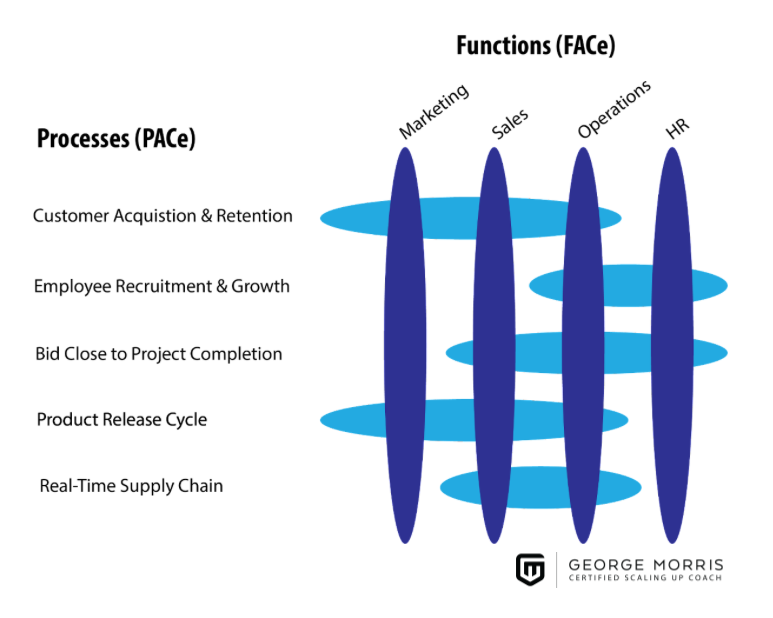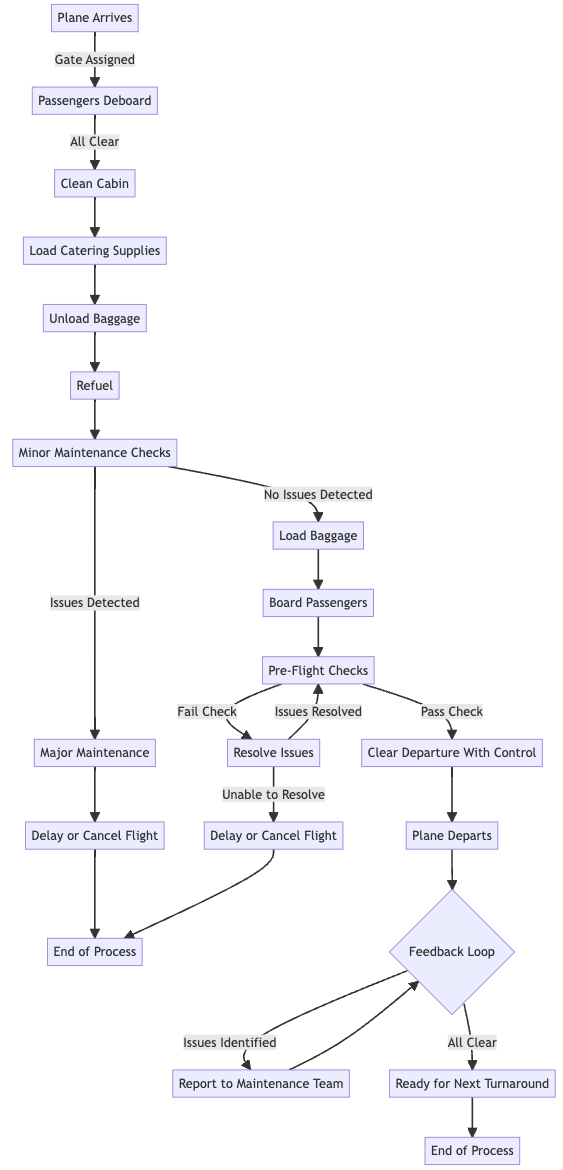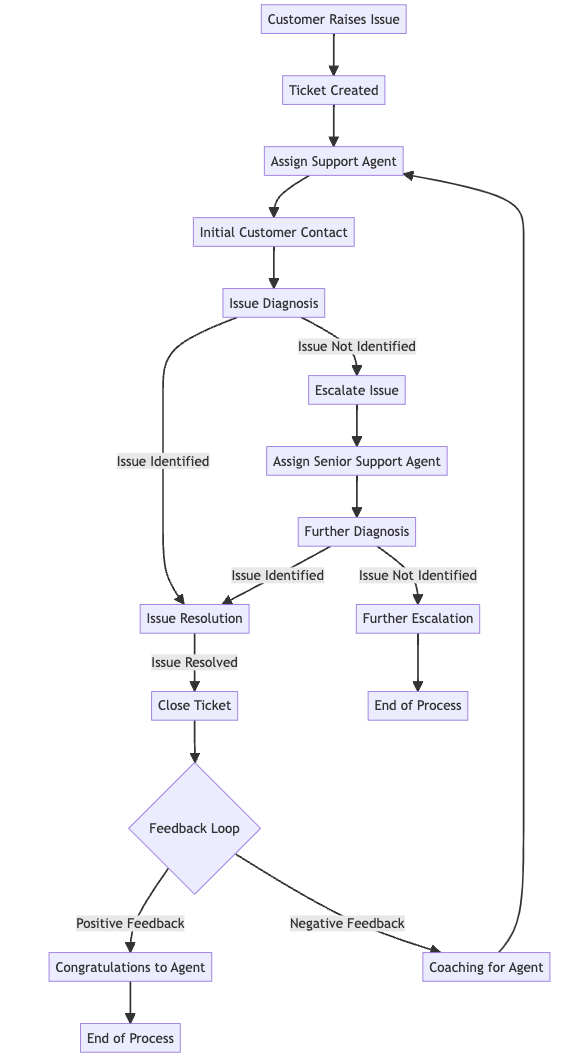Scaling Up PACe
The Definitive Guide
Receive infrequent tools, workshops and articles related to growing your business!
Short Version
Process documentation is a cornerstone that brings clarity, builds teamwork, and facilitates growth. When process documentation is clear and easy to understand, everyone knows what to do, reducing errors and ensuring seamless communication. That's where the Process Accountability Chart, or as known in Scaling Up as PACe.
- Process documentation must evolve with the business, reflecting changes and allowing for proactive updates.
- Great process documentation helps identify bottlenecks, eases new team member onboarding, and is vital for scaling up businesses.
Introduction
I firmly believe that process documentation is more than just an operational necessity—it's an essential cornerstone that brings clarity, builds teamwork, and facilitates growth within an organization. And there's a certain beauty in simplicity, isn't there?
When process documentation is clear and easy to understand, everyone on the team knows exactly what to do, how to do it, and what's expected. It's about breaking down barriers, ensuring seamless communication, and reducing those pesky errors that can slow us down.
But, just like we need to adapt and evolve in life, so too must our process documentation. I know this sounds about as fun as root canal, but stick with me. It's not enough to scribble down procedures, file them away, and then forget about them. Business environments are dynamic and ever-changing. As the business grows and changes, we need our processes to reflect those changes. This is where the benefits of an evolutionary approach to process documentation comes in—allowing us to be proactive and continually update. I suggest keeping the each process to 2 to 3 pages. Yes, that is correct. When the documentation is beyond 3 pages, here's a truth bomb, no one will read it, AND it won't stay updated. It's also why I suggest all teams build their processes in tools like Google Docs or Mural.
Great process documentation is like having a magnifying glass that lets us zoom in on potential bottlenecks or gaps and then take steps to fix them. If you've ever onboarded a new team member, you'll know the value of well-documented processes. It greatly helps new folks understand how we work, easing their transition, and getting them up to speed faster.
Now, let's talk about Scaling Up. In scaling up businesses, process documentation is a vital part of our strategy. It's at the heart of the 'People' pillar in the Scaling Up methodology. The goal here is to reduce complexity and create a rhythm that allows us to move in sync, always aligned with our objectives and driving steadily towards growth. So, by keeping our process documentation simple and adaptive, we can effectively maneuver our business, maintain operational consistency, and scale with intention and clarity. And that, my friend, is how we make our mark in the business world.
Understanding the Scaling Up Process Accountability Chart (PACe)
Before getting into PACe, we must understand it's sibling, FACe (Functional Accountability Chart), which forms the vertical lines or columns. Each column represents a function in your organization, with a dedicated person taking full ownership, eradicating any guesswork about who's in charge. We're not going deep into FACe here but keeping our focus to PACe.
Scaling Up author Verne Harnish said it best, "FACe is how you see your company. PACe is how your customers experience it."

PACe (Process Accountability Chart) lays the horizontal lines or rows. Each row embodies a key process in your business, with a single individual assigned to oversee its smooth operation.
Where these lines intersect, you get a unique conflict between the owner of the process and the owner of the function. Just like a GPS pinpointing a location, any ambiguity gets removed. There's an accountable person both for the function and the process. If any conflict arises at these intersection points, it's resolved through robust dialogues or, ultimately, the CEO's decision. By linking FACe with PACe, we create an accountability matrix (above). This offers an insightful and clear overview of who owns what—both function-wise and process-wise.
Most companies have a org chart, and each person in the org chart has responsibilities. PACe spans the org chart and assigns an owner to each process which can be upgraded, improved, also known as taken through kaizen. It cleans up the handoffs between functions.
Just as upgrading core components in a Formula 1 race car can supercharge its performance and outpace the competition, improving a company's core processes works similarly. Think of your core processes as the engine, the gearbox, or the aerodynamics of a race car. Just as a race car requires these components to work flawlessly and harmoniously to maintain top speed and maneuverability, your business needs efficient and coordinated core processes to achieve peak performance. As you optimize these processes—streamlining actions, eliminating inefficiencies, and reinforcing accountability—you're fine-tuning your business "engine" to generate more power, speed, and agility. You're making sure every part works in perfect sync to propel your company faster toward its strategic goals, just as a well-tuned race car zips seamlessly toward the finish line.
A core process will also have 2 to 3 KPIs that indicate the health of the process, akin to the dashboard of the racecar. If the upgrades were correct, the dashboard will show better performance.
Core processes are also like an NFL playbook. Imagine an NFL receiver running a route. The center snaps the ball to the QB. He drops back. The receiver knows it has 1.2 seconds to run 10 yrs, break right, and go across the middle. When they reach the center, the QB will have already thrown the ball for the receiver to turn and catch. The play will fail if any part of that play is interrupted or the timing is off. That would be a negative KPI.
A series of well-run plays results in a touchdown. We're doing the same thing here with this exercise. Core processes bring the team on the same page and help identify and eliminate wasted time, dropped balls, and missteps.
Our goal with each PACe core process is to make it "better, faster, cheaper." We should be able to apply 2 to 3 KPIs to give us an idea of the health of the process.
Better (Quality): One potential KPI here could be "Error Rate" - a measure of the number of issues or problems that arise during the process, compared to the total number of tasks completed. The lower the error rate, the better the process.
Faster (Efficiency): A KPI to measure speed could be "Average Resolution Time" - this quantifies the average time it takes from the start of a process to its conclusion. In the case of Rackspace's customer service process, it would be the average time from the creation of a support ticket to its closure. The goal here would be to reduce this time, making the process faster.
Cheaper (Cost-effectiveness): A suitable KPI might be "Cost per Resolution" - this could include the total cost (personnel, resources, etc.) involved in resolving a single customer issue. The aim is to lower this cost, making the process cheaper, while maintaining or improving quality and speed.
Remember, KPIs should always align with broader business objectives, and be regularly reviewed and refined as needed.
Core processes are essential operations or activities that contribute significantly to its success and competitive advantage. In contrast, a non-core process is a secondary activity that, while important, does not directly impact the organization's primary objectives or competitive advantage.
Here are some guidelines to help you differentiate between core processes and non-core processes:
- Impact on the organization's objectives: Core processes have a direct and significant influence on achieving the organization's primary goals and objectives. Non-core processes may contribute to the overall operations but are not critical to the organization's success. You must be willing to elevate the important processes from those secondary to the company's goals.
- Unique value proposition: Core processes typically differentiate the organization from its competitors, creating a unique value proposition. Non-core processes, on the other hand, are more generic and may be common across organizations within the same industry.
- Competitive advantage: Core processes often provide a competitive advantage for the organization, allowing it to excel in its industry. Non-core processes, while necessary, do not typically provide the same level of competitive edge.
- Essential to business functioning: Core processes are integral to the business's functioning, and their failure or underperformance may lead to significant disruptions in operations or loss of business. Non-core processes can usually be interrupted or altered without causing major operational issues.
To identify the Core Processes in your organization, assess each process based on these guidelines and prioritize those that significantly impact the organization's success, competitive advantage, and alignment with its core competencies.
Process Documentation Using PACe: A Step-By-Step Guide
The first step to creating your PACe is to identify your business's core processes. Here we are looking for the top 5 to 9 critical operations that your business relies on to deliver its products or services. Start by asking yourself, "What are the essential steps we take to operate and deliver value to our customers?" This could be anything from product development, sales and marketing, to customer service and support. List these out - it's these crucial functions that form the backbone of your PACe.
Now, let's translate these core processes into a PACe. Inspired by Tom Wujec's "How to Draw Toast" method, this approach involves visualizing the process to understand its complexity and identify any opportunities for improvement.
For each core process, break it down into individual steps. Then, create a flowchart illustrating how these steps interact to complete the process. It's like drawing a map, where each step is a landmark on your journey. Remember, the goal here is to identify who owns each process, just as a captain commands a ship. Assign each process to a core team member who will ensure its smooth execution. Another tip, keep your process to under 20 nodes. Nodes are the points in the process.
Now, you've built your a singular process in your PACe!
Building your PACe is just the start. It's essential to regularly review and improve it, much like a gardener tending to their plants. As your business evolves, so too will your processes. Periodically revisit your PACe, evaluating each process for efficiency and effectiveness.
- Ask yourself and your team:
- Are these processes serving us well?
- Can we make them better?
- Are the right people overseeing the right processes?
Don't shy away from tough discussions - they often lead to valuable insights and improvements.
Remember, your PACe isn't set in stone; it's a living, breathing document that grows and adapts with your business.
Documenting your processes using PACe is an adventure - it starts with understanding your terrain (identifying core processes), mapping out your route (building your PACe), regularly checking your map, and adjusting your course as needed (reviewing and improving your PACe). And just as every successful adventure needs a solid plan, every successful business needs a well-documented PACe.
Examples
Southwest Airlines is often cited as an example of successful process optimization. They have been known for their dedication to clear processes and responsibilities. In their 10-minute turnaround process for planes at the gate. Each employee knows exactly what needs to be done and in which sequence, significantly increasing efficiency and allowing Southwest to achieve more flights per plane than competitors.

Ideas for the Southwest KPIs in the 10-Min Turnaround Process
- Turnaround Time: The goal is to have planes ready to fly again within 10 minutes of arrival. Tracking the average turnaround time, and how often it meets the 10-minute goal, can provide a clear indicator of how well the process is functioning.
- Flight Delays or Cancellations Due to Turnaround Issues: Monitor the number of flights delayed or cancelled due to issues identified during the turnaround process. This could include delays due to maintenance issues, baggage handling, or passenger boarding. A high number of delays or cancellations might indicate problems within the turnaround process.
- Issues Detected and Resolved: Track the number of issues detected during the turnaround process and how quickly they are resolved. This KPI can provide insights into the effectiveness of the process checks and the efficiency of the resolution steps.
Rackspace's use of PACe, and their strong focus on a defined customer service process, known as "Fanatical Support," suggests a strong alignment with the principles of PACe. They have a clear set of processes in place for handling customer issues, with each team member understanding their role. This focus on process has been key to their reputation and success in a competitive market.

Rackspace KPIs ideas for their support process.
- Resolution Time: This measures the average time taken from when a customer issue is first raised to when it is resolved. This could be further broken down into stages, such as time to first contact, time to diagnosis, and time to resolution. A lower resolution time usually indicates a healthier process.
- First Contact Resolution Rate: This measures the percentage of issues that are resolved upon first contact with the customer without requiring escalation or further contact. A higher rate here indicates that the customer service team is well-equipped to handle most issues promptly, reducing the need for escalation and providing a better customer experience.
- Customer Satisfaction Score (CSAT): This is a key measure of the quality of the customer service process. It can be gathered through post-resolution surveys asking customers to rate their satisfaction with the support they received. A high CSAT score usually indicates that customers are happy with the service, which is the ultimate aim of the process.
As a Scaling Up Coach, I've seen firsthand the transformative power of the Process Accountability Chart (PACe). It's more than just a tool—it's a strategic compass that helps businesses navigate toward enhanced operations and successful scaling. Working with companies like Southwest Airlines and Rackspace, we've honed their processes, making them leaner, faster, and more cost-effective. PACe's magic lies in its ability to encourage continuous improvement and align everyone's roles with crystal-clear accountability. Yes, it takes effort to implement, but the rewards? They're substantial. By embracing PACe, you're not just documenting processes—you're fostering a culture where every team member contributes to your organization's success. So, I urge you to start creating your PACe today.

